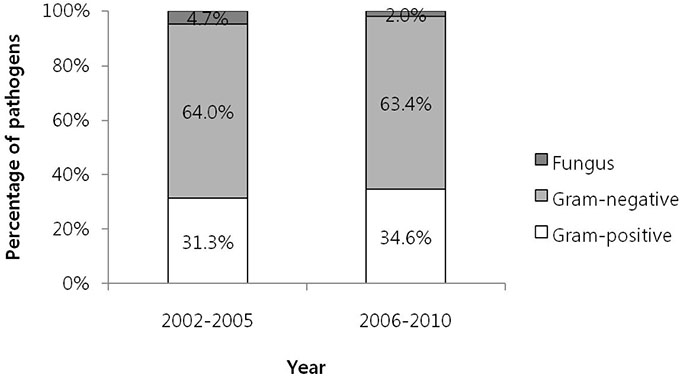Korean J Pediatr Infect Dis.
2012 Dec;19(3):131-140.
Etiological Agents in Bacteremia of Children with Hemato-oncologic Diseases (2006-2010): A Single Center Study
- Affiliations
-
- 1Department of Pediatrics, Seoul National University Children's Hospital, Seoul, Korea. eunchoi@snu.ac.kr
- 2Department of Pediatrics, Seoul National University College of Medicine, Seoul, Korea.
Abstract
- PURPOSE
This study was performed to identify the etiologic agents and antimicrobial susceptibility patterns of organisms responsible for bloodstream infections in pediatric cancer patients for guidance in empiric antimicrobial therapy.
METHODS
A 5-year retrospective study of pediatric hemato-oncologic patients with bacteremia in Seoul National University Children's Hospital, from 2006 to 2010 was conducted.
RESULTS
A total of 246 pathogens were isolated, of which 63.4% (n=156) were gram-negative, bacteria 34.6% (n=85) were gram-positive bacteria, and 2.0% (n=5) were fungi. The most common pathogens were Klebsiella spp. (n=61, 24.8%) followed by Escherichia coli (n=31, 12.6%), coagulase-negative staphylococci (n=23, 9.3%), and Staphylococcus aureus (n=22, 8.9%). Resistance rates of gram-positive bacteria to penicillin, oxacillin, and vancomycin were 85.7%, 65.9%, and 9.5%, respectively. Resistance rates of gram-negative bacteria to cefotaxime, piperacillin/tazobactam, imipenem, gentamicin, and amikacin were 37.2%, 17.1%, 6.2%, 32.2%, and 13.7%, respectively. Overall fatality rate was 12.7%. Gram-negative bacteremia was more often associated with shock (48.4% vs. 11.9%, P<0.01) and had higher fatality rate than gram-positive bacteremia (12.1% vs. 3.0%, P=0.03). Neutropenic patients were more often associated with shock than non-neutropenic patients (39.6% vs. 22.0%, P=0.04).
CONCLUSION
This study revealed that gram-negative bacteria were still dominant organisms of bloodstream infections in children with hemato-oncologic diseases, and patients with gram-negative bacteremia showed fatal course more frequently than those with gram-positive bacteremia.
Keyword
MeSH Terms
-
Amikacin
Bacteremia
Bacteria
Cefotaxime
Child
Escherichia coli
Fever
Fungi
Gentamicins
Gram-Negative Bacteria
Gram-Positive Bacteria
Humans
Imipenem
Klebsiella
Neutropenia
Oxacillin
Penicillins
Retrospective Studies
Shock
Staphylococcus aureus
Vancomycin
Amikacin
Cefotaxime
Gentamicins
Imipenem
Oxacillin
Penicillins
Vancomycin
Figure
Reference
-
1. Viscoli C, Varnier O, Machetti M. Infections in patients with febrile neutropenia: epidemiology, microbiology, and risk stratification. Clin Infect Dis. 2005. 40:S240–S245.
Article2. Pizzo PA. Management of fever in patients with cancer and treatment-induced neutropenia. N Engl J Med. 1993. 328:1323–1332.
Article3. Bodey GP, Buckley M, Sathe YS, Freireich EJ. Quantitative relationships between circulating leukocytes and infection in patients with acute leukemia. Ann Intern Med. 1966. 64:328–340.
Article4. Ramphal R. Changes in the etiology of bacteremia in febrile neutropenic patients and the susceptibilities of the currently isolated pathogens. Clin Infect Dis. 2004. 39:S25–S31.
Article5. Yun BY, Lee HJ. Septicemia in children with neoplastic disease. J Korean Pediatr Soc. 1992. 35:1481–1492.6. Lee DG, Yoon JM, Cho JH, Choi SM, Park YH, Kim YJ, et al. Selective bowel decontamination for the prevention of infection in acute myelogenous leukemia: a prospective vandomized trial. Korean J Med. 2001. 60:167–174.7. Kim SH, Lee YA, Eun BW, Kim NH, Lee JA, Kang HJ, et al. Etiological agents isolated from blood in children with hemato-oncologic diseases (2002-2005). Korean J Pediatr. 2007. 50:56–64.
Article8. Kim YH, Lee HD, Hah JO. Bacteremia in pediatric cancer patients: causative organisms and antibiotic sensitivities. Korean J Pediatr. 2005. 48:619–623.
Article9. Park HW, Youn HS, Im HJ, Kim MN, Seo JJ, Moon HN. Risk factors of bloodstream infection associated mortality in pediatric patients with hemato-oncologic disease. Korean J Hematol. 2007. 42:343–352.
Article10. Wisplinghoff H, Seifert H, Wenzel RP, Edmond MB. Current trends in the epidemiology of nosocomial bloodstream infections in patients with hematological malignancies and solid neoplasms in hospitals in the United States. Clin Infect Dis. 2003. 36:1103–1110.
Article11. González-Barca E, Fernández-Sevilla A, Carratala J, Grañena A, Gudiol F. Prospective study of 288 episodes of bacteremia in neutropenic cancer patients in a single institution. Eur J Clin Microbiol Infect Dis. 1996. 15:291–296.12. Chang MS, Sung KW, Kim YJ. Clinical characteristics of bacteremia in children with cancer. Korean J Pediatr Infect Dis. 2011. 18:201–206.13. Choi EH, Pyo JW, Park JY, Kwon KB, Yun BY, Shin HY, et al. Infections in children with neoplastic disease. J Korean Pediatr Soc. 1995. 38:366–377.
Article14. Oliveira AL, de Souza M, Carvalho-Dias VMH, Ruiz MA, Silla L, Tanaka PY, et al. Epidemiology of bacteremia and factors associated with multi-drug-resistant gram-negative bacteremia in hematopoietic stem cell transplant recipients. Bone Marrow Transplant. 2007. 39:775–781.
Article15. Song JH, Joo EJ. The crisis of antimicrobial resistance: current status and future strategies. J Korean Med Assoc. 2010. 53:999–1005.
Article16. Lee H, Kim CK, Lee J, Lee SH, Ahn JY, Hong SG, et al. Antimicrobial resistance of clinically important bacteria isolated from 12 hospitals in Korea in 2005 and 2006. Korean J Clin Microbiol. 2007. 10:59–69.
Article17. Paul M, Bishara J, Levcovich A, Chowers M, Goldberg E, Singer P, et al. Effectiveness and safety of colistin: prospective comparative cohort study. J Antimicrob Chemother. 2010. 65:1019–1027.
Article18. Whimbey E, Kiehn TE, Brannon P, Blevins A, Armstrong D. Bacteremia and fungemia in patients with neoplastic disease. Am J Med. 1987. 82:723–730.
Article19. Tamburro R. Pediatric cancer patients in clinical trials of sepsis: factors that predispose to sepsis and stratify outcome. Pediatr Crit Care Med. 2005. 6:S87–S91.20. Viscoli C. Management of infection in cancer patients: studies of the EORTC International Antimicrobial Therapy Group (IATG). Eur J Cancer. 2002. 38:S82–S87.
- Full Text Links
- Actions
-
Cited
- CITED
-
- Close
- Share
- Similar articles
-
- Etiology of Bacteremia in Children with Hemato-oncologic Diseases from a Single Center from 2011 to 2015
- Etiology of Bacteremia in Children With Hemato-Oncologic Diseases From 2013 to 2023: A Single Center Study
- A Survey for Causative Organisms and Antimicrobial Susceptabilities of Bacteremia in a Single Center Children with Hemato-Oncologic Diseases (2004~2006)
- Clinical Investigation of Bacteremia in Children with Hemato-Oncologic Diseases
- Bloodstream Infections in Children with Cancer between 2005 and 2008 in a Single Center



